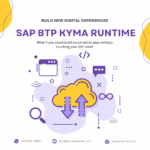Introduction
In today’s fast-paced business landscape, companies are often caught in a cycle of repetitive, manual tasks that drain resources and hinder strategic progress. Despite advances in technology, many organizations still find themselves bogged down by routine work such as data entry, invoice processing, and report reconciliation. These tasks not only slow down operations but also divert valuable human potential from higher-value activities like strategy development and creative problem-solving.
The challenge is clear: It isn’t enough to simply implement new technology. The key lies in how well that technology is integrated into daily workflows to streamline operations and improve overall efficiency. This is where SAP Intelligent Robotic Process Automation (RPA) comes into play. Rather than just automating tasks for the sake of automation, SAP Intelligent RPA offers a strategic solution that reengineers processes, reduces manual intervention, and paves the way for a more agile organization.
In this blog, we will delve into the issues caused by manual processes, explore the strategic advantages of SAP Intelligent RPA, and provide practical insights into how organizations can adopt this solution to create a smoother, more efficient workflow.
The Core Problem: The Hidden Costs of Manual Processes
Consider a typical day in a mid-sized enterprise. Employees spend countless hours entering data into spreadsheets, reconciling financial records, and processing routine documents. While these tasks might seem trivial on their own, the cumulative effect is significant:
- Lost Time: Hours wasted on repetitive tasks that could be automated.
- Inconsistencies: Manual processes often lead to errors and data discrepancies, which can result in faulty reporting.
- Delayed Decision-Making: With information arriving late or in fragmented form, leadership is forced to make decisions based on outdated data.
- Employee Frustration: Repetitive tasks can sap motivation and divert focus from strategic work, leading to a demoralized workforce.
These issues are not just operational inconveniences; they represent a fundamental barrier to digital transformation. When teams are overwhelmed by manual tasks, they lack the bandwidth to innovate, adapt to market changes, or provide the level of service that modern businesses demand.
The SAP Intelligent RPA Solution: A New Approach to Process Optimization
A Paradigm Shift in Workflow Design
SAP Intelligent RPA is not about simply replacing human effort with bots—it’s about redesigning processes so that the technology serves as an integral part of the business workflow. The platform enables organizations to automate routine tasks, thereby freeing up employees to focus on strategic initiatives. But more importantly, it facilitates a deeper integration of systems, ensuring that data flows seamlessly from one process to another.
Key Features and Their Strategic Impact
1. Streamlining Routine Tasks
At the heart of SAP Intelligent RPA is the capability to automate mundane, repetitive tasks. For instance, tasks like data entry, invoice matching, and report generation can be automated with high precision. This not only reduces the risk of human error but also ensures that processes are completed consistently and quickly.
- Example: A multinational corporation reduced its invoice processing time by 70% after automating the matching of invoices with purchase orders, allowing the finance team to redirect their focus to strategic analysis.
2. Enhancing Data Integrity
Manual processes are prone to errors that can compromise the quality of data across the organization. SAP Intelligent RPA employs rule-based automation to verify and validate data as it moves between systems. This ensures that the information used for decision-making is both accurate and up-to-date.
- Example: A financial institution improved its reporting accuracy significantly by automating the reconciliation of transaction data, thereby reducing costly errors and streamlining compliance.
3. Seamless Integration with Existing Systems
One of the most critical aspects of digital transformation is ensuring that new technology works in harmony with existing systems. SAP Intelligent RPA is designed to integrate smoothly with SAP ERP, CRM, and even non-SAP systems. This integration minimizes disruptions and guarantees that data remains consistent across platforms.
- Example: A retail chain, burdened with siloed systems, managed to consolidate customer and inventory data into a unified system through SAP Intelligent RPA, leading to better inventory management and improved customer service.
4. Facilitating Agile Process Redesign
Adopting SAP Intelligent RPA encourages organizations to rethink their workflows. Rather than simply automating existing processes, companies are prompted to evaluate and redesign workflows for maximum efficiency. This proactive approach ensures that automation not only saves time but also enhances overall productivity.
- Example: An HR department, previously swamped with administrative tasks, used SAP Intelligent RPA to streamline the onboarding process. This redesign reduced the time to onboard new hires by half and improved the overall employee experience.
Real-World Applications: Case Studies of Transformation
Case Study 1: Revamping Invoice Processing
A global manufacturing firm struggled with a labor-intensive invoice processing system. Manual data entry and reconciliation resulted in delays and errors that affected supplier relationships and financial reporting. By implementing SAP Intelligent RPA, the company automated the entire invoice processing workflow. Within a few months, they saw a dramatic decrease in processing time and a significant reduction in errors. The finance team could now concentrate on forecasting and budgeting, rather than chasing down discrepancies.
Case Study 2: Streamlining HR Operations
A large organization’s HR department was overwhelmed by the volume of administrative tasks—from updating employee records to managing leave requests. These tasks were not only time-consuming but also prone to mistakes that led to employee dissatisfaction. SAP Intelligent RPA was deployed to handle these repetitive tasks, resulting in faster processing times and more reliable data. With routine tasks automated, HR professionals were free to focus on strategic initiatives like talent development and employee engagement, fostering a more dynamic work environment.
Case Study 3: Improving Customer Service Efficiency
In a customer-centric company, slow response times and inconsistent handling of support tickets were major pain points. The customer service team spent excessive hours on routine queries that could be easily addressed through automation. SAP Intelligent RPA was used to automate responses to common inquiries and streamline ticket routing. This not only improved response times but also enhanced the overall customer experience. Customer satisfaction scores increased, and the support team was able to handle more complex issues more effectively.
Best Practices for Implementing SAP Intelligent RPA
While the benefits of SAP Intelligent RPA are clear, successful implementation requires thoughtful planning and execution. Here are some best practices to consider:
1. Identify High-Impact Processes
Not every task is ripe for automation. Begin by identifying processes that are highly repetitive, error-prone, and time-consuming. Focus on areas where automation will yield the greatest return on investment.
2. Engage Stakeholders Early
Bring together business users, process owners, and IT teams from the outset. Their insights are invaluable in designing workflows that are both efficient and aligned with business objectives.
3. Start Small, Scale Gradually
Begin with pilot projects that deliver quick wins. Once you’ve demonstrated the value of automation in a specific area, gradually expand to other processes. This phased approach helps manage risk and builds momentum within the organization.
4. Monitor and Refine Continuously
Automation is not a set-and-forget solution. Establish metrics to monitor performance and gather feedback from users. Use these insights to refine processes and ensure that the automation continues to meet evolving business needs.
5. Invest in Change Management
Shifting from manual to automated processes can be challenging for employees. Invest in training and support to help your teams adapt. Clear communication about the benefits of automation can help alleviate concerns and foster a culture of continuous improvement.
The Road Ahead: Embracing a New Era of Operational Excellence
The future of work is not about eliminating human effort; it’s about reallocating human potential to where it matters most. By reducing the burden of repetitive tasks, SAP Intelligent RPA enables organizations to focus on strategy, innovation, and growth.
As companies navigate the complexities of digital transformation, those that streamline operations and eliminate inefficiencies will be best positioned to thrive. SAP Intelligent RPA is not a magic bullet, but it is a powerful tool that, when implemented thoughtfully, can reshape how businesses operate.
The shift is clear: Organizations that invest in intelligent process automation not only save time and reduce errors—they also create an environment where strategic thinking can flourish. In a rapidly evolving market, the ability to respond quickly, adapt to change, and make data-driven decisions is not just an advantage—it’s a necessity.
Conclusion
The challenge of manual, repetitive tasks is a significant barrier to achieving operational excellence. SAP Intelligent RPA offers a strategic approach to addressing this challenge by reengineering workflows, ensuring data accuracy, and integrating seamlessly with existing systems. It allows organizations to shift from a reactive mode—where every day is consumed by routine tasks—to a proactive mode, where time and resources are invested in innovation and strategic growth.
In today’s competitive landscape, the difference between companies that lead and those that lag behind is clear. It’s not just about having the latest technology—it’s about how that technology is used to create an efficient, agile, and forward-thinking enterprise. With SAP Intelligent RPA, the future of work is within reach. It’s time to reimagine your workflows, reallocate your resources, and rebuild your processes to meet the demands of a new era.
Are you ready to rethink how work gets done? The journey to operational excellence starts with a single step—transform your processes and unlock the true potential of your workforce.











